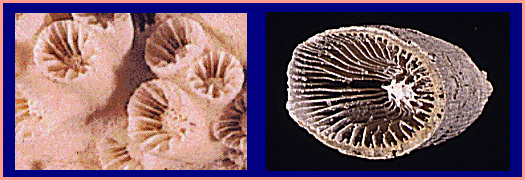
Scleractinian and Rugose corallites shown with
permission
from the U. California Museum of Paleontology
Invertebrate Paleontology Lab #3
Cnidaria
Click on the lab title to see the University of
California
Museum of Paleontology web page
Read BEFORE Coming to
Lab:
Benton & Harper, chapter 11
and see this web link on coral
paleoclimatology
| Note: Highlighted words are links to
the UCMP webpages
on that subject. (To go directly to the UCMP home page click here.) |
Introduction
This week we will be examining fossil record of
corals,
or Anthozoa,
a large class of organisms in the Phylum Cnidaria. We will also
be
looking at an extinct, problematic group currently linked to the
Cnidaria, the Conulariida
(Middle
Ordovician-Triassic). The Anthozoa are currently
classified
into three Subclasses, of which one Subclass, the Zoantharia
(stony
corals and sea anemones) is common as fossils in the geologic
record.
The three Orders of the Subclass Zoantharia we will be examining are
the
Tabulata
(tabulate corals) which range from Early Ordovician - Permian), the Rugosa
(tetracorals, which range from Middle Ordovician to Permian) and the Scleractinia
(hexacorals, which range from Middle Triassic to Recent).
The
early fossil record of Anthozoa reaches into the Vendian (latest
Precambrian
time) as soft-bodied imprints, but the record of reef building corals
begins
in Ordovician time. An interesting feature of the coral fossil
record
is that we can see how the reef biome has persisted through Phanerozoic time,
with a few important gaps .
Different groups of organisms have built those reefs (remember the Archaeocyathids
and Stromatoporoids we studied in Lab #2) but the biome persists.
Phylum Cnidaria, Class Anthozoa
(Cambrian-Recent)
(see video, approximately 10 minutes, on biology of Cnidaria)
| Basic Facts & Terms to Know about Cnidaria: They
are: |
|
| 1. |
Eukaryotes |
| 2. |
Metazoans with true tissues, nervous, muscular,
and reproductive
systems (no organs) |
| 3. |
Specialized cells |
| 4. |
Radial in symmetry (Rugosa: 4-fold aka
Tetracorals,
Scleractinians: 6-fold aka Hexacorals) |
| 5. |
free-swimming in larval stage (planula
larvae):
sessile (attached)as adults |
| 6. |
Reproduce sexually and asexually (by
budding) |
| 7. |
structurally supported by calcium carbonate
(aragonite) exoskeleton
called the corrallum |
| 8. |
Marine environments, Sessile (Attached)or
Encrusting
and can be Reef Builders or Solitary. |
| 9. |
Most reef builders require symbiotic zooxanthellae
(dinoflagellate
algae) partners, which photosynthesize and therefore need
shallow
water (Consider-why is this?). Many solitary corals live in
deeper
water, and do not have symbiotic algae. |
What ecological factors can you expect to be important to their
survival?
Consider the problems of substrate type, respiration, feeding, and
avoiding
predation.
Part I. Group Assignment:
Corals
and Paleoclimate Records 20 pts.
We will examine oxygen isotope data from coral records around the world
and see how corals can be used to track changes in sea surface
temperature,
including El Niño events, over century scale time frames.
This is just one application of corals in geological science.
Part II. Individual Assignment: Draw and
Label
4 Specimens of Cnidaria 20 pts.
Label the corallum, the corallite, the epitheca,
the tabulae, and the septa, as well as the Order, Genus,
and
time range for the specimen
Part III. Five Minute Paper (If Time Permits). Write a
short 1 - 2 sentence answer to a proposed question 5 points
Consider the Following Questions as
You
Examine Each of the Fossil Corals in Lab:
1. How can you know that this is a fossil coral
(consider symmetry, exoskeleton structure)?
2. Can you see any useful details with your
handlens?
3. With what kind of marine environment do you
think
this fossil associated?
Phylum Cnidaria
Class Anthozoa
Subclass Zoantharia
Order Tabulata Geologic Range Lower
Ordovician-Permian
Tabulate coral shown with permission from the U.
California
Museum of Paleontology
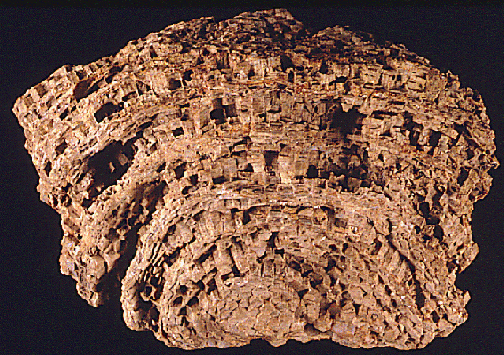
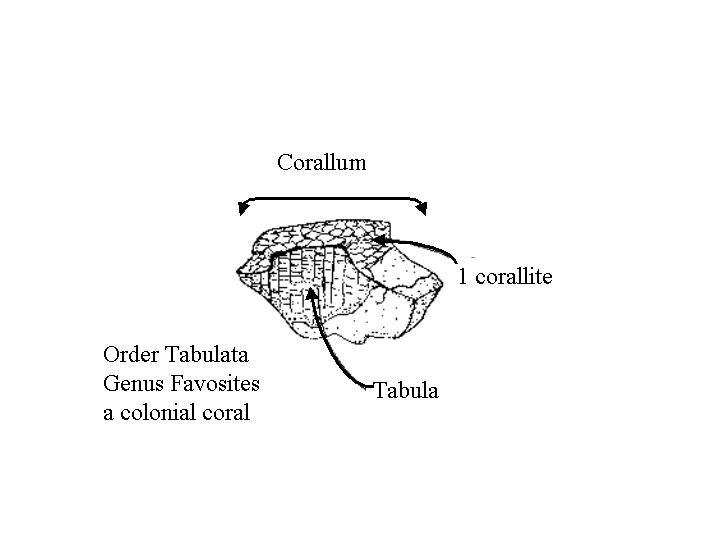
Look for the horizontal tabulae, which support and divide the
corallites,
the individual vertical tubes.
Each polyp or zooid in the colony was nested in its own corallite.
Be sure to see the Syringopora specimen from the
Mississippian
age Pahasapa Formation, a common sight for Black Hills field camp
students!
Also, be sure to look at Favosites (the "honeycomb coral") ,
an important Silurian-Devonian reef builder
and at Halysites (the "chain coral"), a common Silurian reef
builder
Phylum Cnidaria
Class Anthozoa
Subclass Zoantharia
Order Rugosa Geologic
Range
Middle
Ordovician - Permian
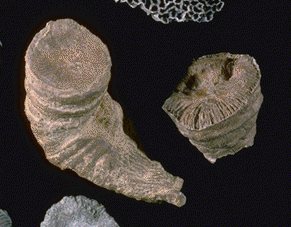
Solitary Rugose horn corals shown with permission
from
the U. California Museum of Paleontology
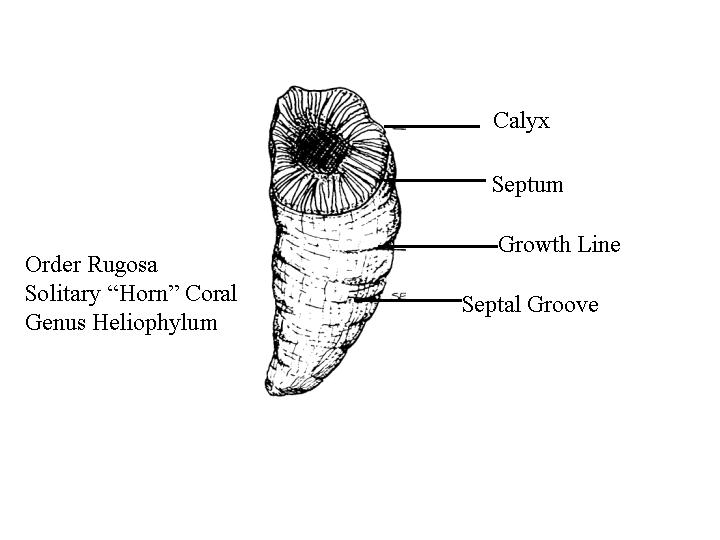
Be sure to examine both the solitary rugose horn corals AND the
colonial
rugose corals. Can you tell the difference between a Rugose and
Scleractinian
Colonial Coral?
Rugose Corals vs. Scleractinian Corals:
Differences
in the Arrangement of the Septa
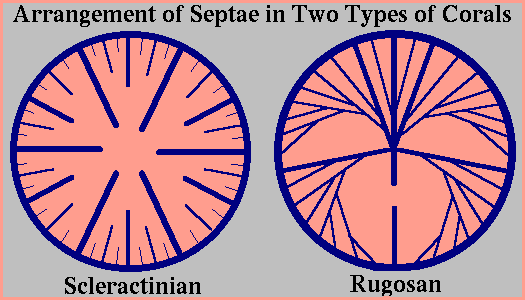
shown with permission from the U. California Museum of
Paleontology
Phylum Cnidaria
Class Anthozoa
Subclass Zoantharia
Order Scleractinia Geologic
Range Middle Triassic - Recent
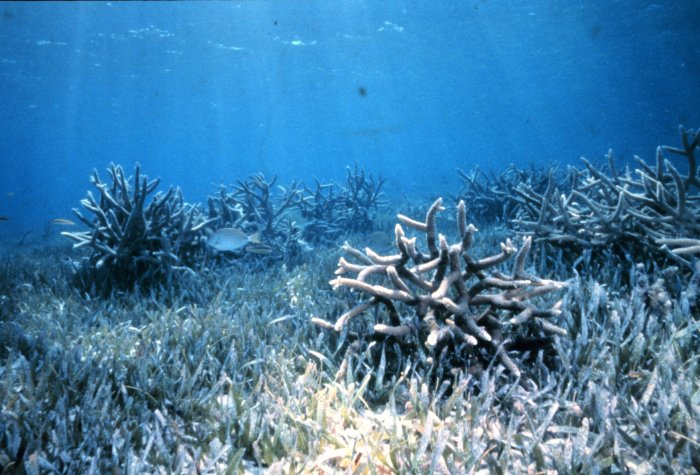
NOAA Photo Library Image ID: reef2564, The Coral Kingdom Collection
Photographer: Florida Keys National Marine Sanctuary Staff
Credit: Florida Keys National Marine Sanctuary
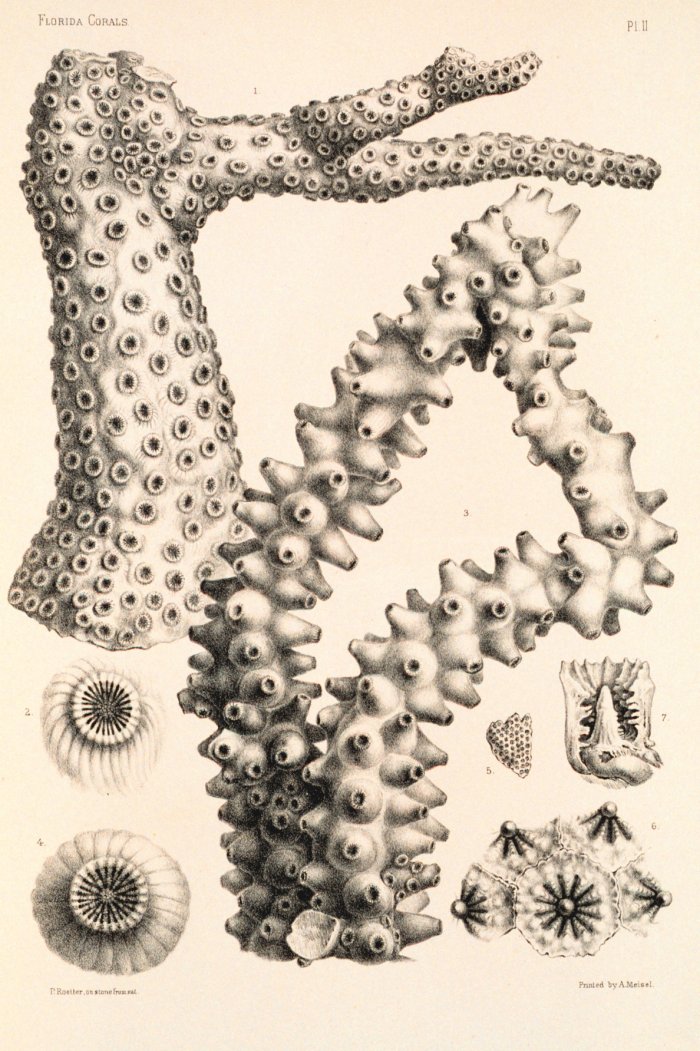
NOAA Photo Library Image ID: reef2502, The Coral Kingdom
Collection
Location: Florida Photo Date: 1851Field Studies
Figures
1 and 2, Oculina robusta Pourtales. Figures 3 and 4, Oculina varicosa
Leseuer.
Figures 5-7, Astrocoenia pectinata Pourtales. In: "Report on the
Florida
Reefs", 1880, by Louis Agassiz. Memoirs of the Museum of Comparative
Zoology
at Harvard College, Vol. VII, No. 1. Plate II. These plates help
document
the oldest studies of the Florida Reefs.
For More Information...
Want to Find Great Images of Corals and Coral Reefs?
Check out the NOAA photo library at www.photolib.noaa.gov/reef
Interested in what can be done with fossilized
corals?
Want to know more?
Here are some recent papers (published on-line) on the
subject...
Chen, Chaolun Allen; Wallace, Carden C.; Wolstenholme, Jackie,
2002.
Analysis of the mitochondrial 12S rRNA gene supports a two-clade
hypothesis
of the
evolutionary history of scleractinian corals. Molecular
Phylogenetics and Evolution Volume: 23, Issue: 2, May 2002. pp. 137
- 149.
Chen, Jun-Yuan; Oliveri, Paola; Gao, Feng; Dornbos, Stephen Q.; Li,
Chia-Wei; Bottjer, David J., 2002. Precambrian Animal Life:
Probable
Developmental and Adult Cnidarian Forms from Southwest
China.
Developmental Biology Volume: 248, Issue: 1, August 1, 2002. pp.
182-196.
Feist, Raimund; Ivanov, Kirill S.; Sapelnikov, Vadim P.; Ancigin,
Nicolay
Y.Y.; Ivanov, Sviatoslav N., 1997. Correlations between the
evolution
of benthic faunal communities and convergent movements of
lithospheric
blocks from the Silurian to the Late Devonian in the mid-Palaeozoic
Uralian
basin. Tectonophysics Volume: 276, Issue: 1-4, July
30, 1997. pp. 301-311.
Klein, R.; Tudhope, A.W.; Chilcott, C.P.; Pätzold, J.;
Abdulkarim,
Z.; Fine, M.; Fallick, A.E., 1997. Evaluating southern Red Sea
corals
as a proxy record for the Asian monsoon. Earth and Planetary
Science
Letters Volume: 148, Issue: 1-2, April, 1997. pp. 381-394.
Stanley, Jr., George, D., 2003. The evolution of modern corals
and their early history, Earth-Science Reviews Volume: 60,
Issue:
3-4. pp. 195-225.







